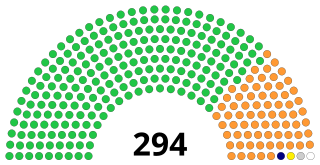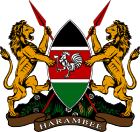
Since becoming independent of the United Kingdom in 1970, Fiji has had four constitutions, and the voting system has changed accordingly.

The Victorian Legislative Council (VLC) is the upper house of the bicameral Parliament of Victoria, Australia, the lower house being the Legislative Assembly. Both houses sit at Parliament House in Spring Street, Melbourne. The Legislative Council serves as a house of review, in a similar fashion to its federal counterpart, the Australian Senate. Although, it is possible for legislation to be first introduced in the Council, most bills receive their first hearing in the Legislative Assembly.

Elections in Kenya take place within the framework of a multi-party democracy and a presidential system. The President, Senate and National Assembly are directly elected by voters, with elections organised by the Independent Electoral and Boundaries Commission (IEBC).

The Parliament of Zimbabwe is the bicameral legislature of Zimbabwe composed of the Senate and the National Assembly. The Senate is the upper house, and consists of 80 members, 60 of whom are elected by proportional representation from ten six-member constituencies corresponding to the country's provinces. Of the remaining 20 seats, 18 are reserved for chiefs, and two for people with disabilities. The National Assembly is the lower house, and consists of 270 members. Of these, 210 are elected from single-member constituencies. The remaining 60 seats are reserved for women, and are elected by proportional representation from ten six-member constituencies corresponding to the country's provinces.

The West Bengal Legislative Assembly is the unicameral legislature of the Indian state of West Bengal. It is located in the B. B. D. Bagh area of Kolkata, the capital of the state. Members of the Legislative assembly are directly elected by the people. The legislative assembly comprises 294 Members of Legislative Assembly, all directly elected from single-seat constituencies. Its term is five years, unless sooner dissolved.
The Yukon Territorial Council was a political body in the Canadian territory of Yukon, prior to the creation of the Yukon Legislative Assembly. Although not a full legislature, the council acted as an advisory body to the Commissioner of Yukon, and had the power to pass non-binding motions of legislation which would be forwarded to the commissioner for consideration.

The Colony and Protectorate of Kenya, commonly known as British Kenya or British East Africa, was part of the British Empire in Africa. It was established when the former East Africa Protectorate was transformed into a British Crown colony in 1920. Technically, the "Colony of Kenya" referred to the interior lands, while a 16 km (10 mi) coastal strip, nominally on lease from the Sultan of Zanzibar, was the "Protectorate of Kenya", but the two were controlled as a single administrative unit. The colony came to an end in 1963 when an ethnic Kenyan majority government was elected for the first time and eventually declared independence.
The Jammu and Kashmir Legislative Assembly also known as the Jammu and Kashmir Vidhan Sabha is the legislature of Indian union territory of Jammu and Kashmir.

General elections were held in East Africa Protectorate in March and April 1920, the first elections in the country. The Legislative Council had previously consisted entirely of appointed members. The new Council consisted of 11 elected white members, two appointed members representing the Indian population and one appointed member representing the Arab population, as well as a number of appointees by the Governor. This allowed the Council representative, although not responsible government. The territory became Kenya Colony on 23 July.

General elections were held in Kenya Colony on 2 April 1924. The elections were the first under a new Constitution which saw suffrage extended to Indians and Arabs, who were allotted five and one elected seat in the Legislative Council respectively, alongside the eleven elected seats for the white population, although appointed members were still the majority. Whilst all adult Indian residents were given the right to vote, in the Arab community only men literate in Arabic or Swahili and resident in the country for two years were enfranchised, as the community had requested that women not be given the right to vote. One member was appointed to represent the majority black population.

General elections were held in Kenya Colony on 12 February 1927.

General elections were held in Kenya Colony in 1934, with the first seats elected on 28 March. Four candidates were returned unopposed in the eleven Europeans constituencies, whilst the remaining seven constituencies were contested by 18 candidates. For the five Indian seats, there were 17 candidates. Voter turnout in the White seats was the highest since elections were introduced. The Council convened for the first time after the election on 24 April.

General elections were held in Kenya Colony between 26 March and 2 April 1938. Three of the eleven white seats in the Legislative Council were uncontested, whilst all Indian seats were contested, and saw more businessmen were elected than politicians. Lady Sidney Farrar became the country's first female Legislative Council member after defeating Conway Harvey in the Nyanza constituency by two votes.

General elections were held in Kenya in 1952.
The provincial councils were the legislatures of the four original provinces of South Africa. They were created at the foundation of the Union of South Africa in 1910, and abolished in 1986 when they were replaced by a strengthened executive appointed by the State President. The four provincial councils were the Cape Provincial Council, the Natal Provincial Council, the Transvaal Provincial Council and the Orange Free State Provincial Council.

General elections were held in Kenya in May 1948.

The Kenya Indian Congress (KIC) was a political party in Kenya.

The Kenya Freedom Party (KFP) was a political party in Kenya.

The Legislative Council of Kenya (LegCo) was the legislature of Kenya between 1907 and 1963. It was modelled on the Westminster system. It began as a nominated, exclusively European institution and evolved into an elected legislature with universal suffrage. It was succeeded by the National Assembly in 1963.
The Devonshire White Paper or Devonshire Declaration was a document written in 1923 by the colonial secretary Victor Cavendish, 9th Duke of Devonshire, regarding the status of settlers and natives in the Kenya Colony, and East Africa more broadly. The paper stated that whenever the interests of the native Africans clashed with those of Asian, European, or Arab settlers, those of the Africans should prevail. The Declaration blocked the move towards self-government advocated by the colonialists, and in its place advocated a policy of trusteeship, whereby the imperial state would protect the interests of Africans. Although the Paper had little effect on the welfare of native Africans, it nonetheless set a precedent for future conflict resolution between the various groups living in the colony.






